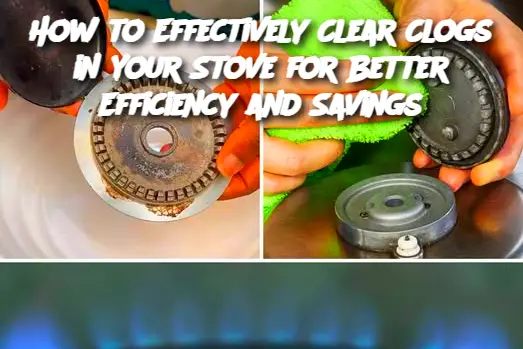Introduction:
A clogged stove can cause a number of frustrating issues, from poor cooking performance to increased energy consumption. Whether it’s a gas or electric stove, blockages in the burners or vents can impede airflow, resulting in uneven cooking and potentially higher utility bills. Fortunately, clearing these clogs is easier than you might think. With a few simple steps and routine maintenance, you can restore your stove’s performance, improve efficiency, and save money in the long run. In this guide, we’ll walk you through the process of removing common stove clogs, ensuring that your kitchen appliances work at their best.
Ingredients (Materials Needed):
Cleaning brush (with stiff bristles)
Baking soda
Vinegar
Dish soap
A screwdriver (if needed to remove parts)
Paper towels or a microfiber cloth
Warm water
Small cleaning brush or toothpick
Mild degreaser (optional)
A small vacuum or compressed air canister (optional)
Instructions:
Turn Off the Stove and Unplug It:
Before starting any maintenance, ensure that your stove is off, unplugged (if electric), or the gas supply is turned off (if gas). This is important for your safety.
Remove Burner Grates or Heating Elements:
For gas stoves, remove the burner grates and lift the burner caps off the gas valves. For electric stoves, carefully remove the heating elements. You may need a screwdriver to detach some parts, especially if you’re working with a built-in stovetop.
Clean the Burner Heads or Coils:
Use a cleaning brush with stiff bristles to scrub any food particles, grease, or dirt from the burner heads or coils. You can also soak the burner heads in a mixture of warm water, baking soda, and a few drops of dish soap to help loosen stuck grime. After soaking for 10-15 minutes, scrub them clean and rinse them with warm water.
Clear Out Clogged Air Vents:
For gas stoves, clogged air vents can cause uneven cooking and may even pose a safety risk. Use a small brush or a toothpick to clear out any debris or food particles from the vent openings. If the clog is stubborn, you can try gently blowing it out with compressed air or using a small vacuum to suck up any particles.
Check for Any Gas Line Obstructions:
If you suspect there is a clog in your gas lines (for gas stoves), it’s important to contact a professional. Never attempt to clean or fix gas line issues yourself, as this can be hazardous.
Clean the Stove Surface:
Once the burner components are cleaned, wipe down the stovetop surface with a damp microfiber cloth or paper towel. Use a mild degreaser if necessary to remove stubborn stains or greasy buildup. Be careful not to use harsh chemicals on sensitive parts.
Reassemble the Stove:
Once everything is clean and dry, reassemble the stove by carefully putting back the burner heads, grates, or heating elements. Ensure all parts are properly secured.
Test the Stove:
Plug the stove back in (for electric) or turn on the gas supply (for gas). Test the burners to make sure they light up properly and cook evenly. If the stove still has issues, further inspection might be necessary.
Tips for Serving and Storing:
Routine Maintenance:
Regularly clean your stove after every use to prevent the buildup of grease, grime, and food particles. This will help you avoid clogs and keep your stove working efficiently.
Proper Ventilation:
Ensure your kitchen is well-ventilated while cooking, as this helps reduce the accumulation of grease around burners and air vents.
Storing Parts:
When removing parts like burner heads or heating elements for cleaning, keep them organized in a safe space to avoid losing any small components.
Variants:
For Gas Stoves:
For gas stoves, in addition to regular cleaning, inspect the gas line for leaks or blockages. You can use a mixture of dish soap and water to check for leaks around the gas connections. If bubbles appear, there may be a leak, and it’s time to call a professional.
For Electric Stoves:
Electric stoves with coils can also experience clogs from food particles getting stuck in between the coils. Cleaning with a mild baking soda paste or vinegar and water solution can help dissolve any stuck-on residue. Be sure to check that the coils are fully dry before reinserting them.
For Induction Stoves:
Induction stovetops don’t have burners like traditional gas or electric stoves, but food particles can still cause issues. Clean the cooktop regularly with a mild cleaner designed for induction stoves, and wipe up any spills immediately to prevent buildup.
ADVERTISEMENT

